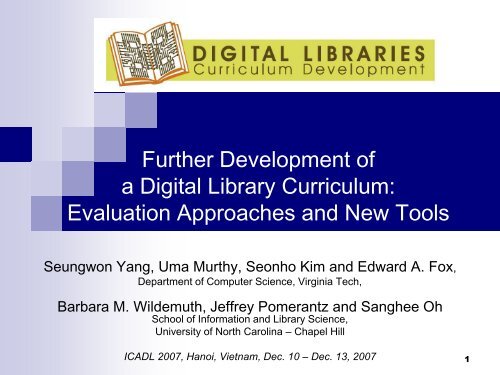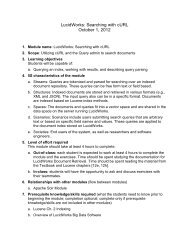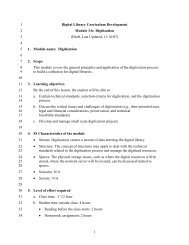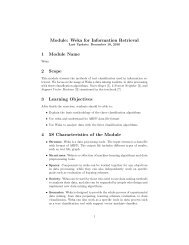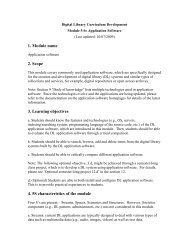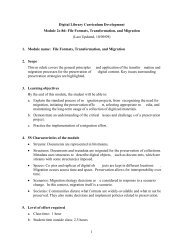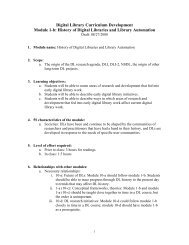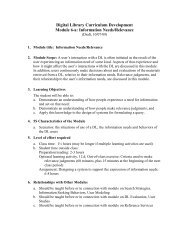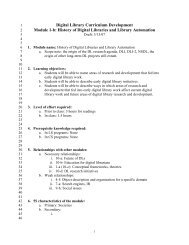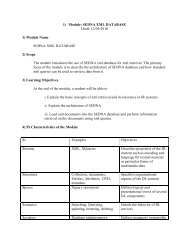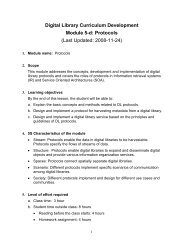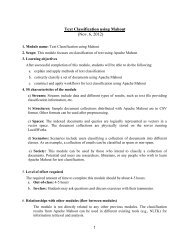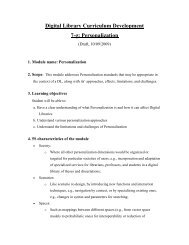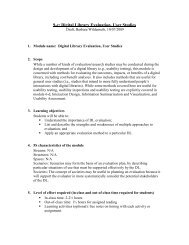Presentation Slides - Digital Library Curriculum Project - Virginia Tech
Presentation Slides - Digital Library Curriculum Project - Virginia Tech
Presentation Slides - Digital Library Curriculum Project - Virginia Tech
Create successful ePaper yourself
Turn your PDF publications into a flip-book with our unique Google optimized e-Paper software.
Further Development of<br />
a <strong>Digital</strong> <strong>Library</strong> <strong>Curriculum</strong>:<br />
Evaluation Approaches and New Tools<br />
Seungwon Yang, Uma Murthy, Seonho Kim and Edward A. Fox,<br />
Department of Computer Science, <strong>Virginia</strong> <strong>Tech</strong>,<br />
Barbara M. Wildemuth, Jeffrey Pomerantz and Sanghee Oh<br />
School of Information and <strong>Library</strong> Science,<br />
University of North Carolina – Chapel Hill<br />
ICADL 2007, Hanoi, Vietnam, Dec. 10 – Dec. 13, 2007<br />
1
Acknowledgements (Selected)<br />
• Faculty / Staff / Others<br />
Module evaluators, Advisory Board members,<br />
<strong>Digital</strong> <strong>Library</strong> Research Lab members, Susie<br />
Marion, Sidewalk team (David Maier, Lois<br />
Delcambre, Sudarshan Murthy) …<br />
• Sponsor<br />
US National Science Foundation Grants<br />
• IIS-0535057 to VT<br />
• IIS-0535060 to UNC-CH<br />
2
Overview<br />
• Introduction<br />
• DL curriculum framework<br />
• Development lifecycle<br />
• Future work<br />
• Invitation<br />
3
Introduction<br />
• Interdisciplinary project<br />
<br />
• Goal<br />
VT CS & UNC-CH SILS<br />
DL lesson modules courses<br />
Community<br />
4
Introduction<br />
• Team<br />
<br />
<br />
VT: Dr. Edward A. Fox (PI), Seungwon Yang<br />
UNC-CH: Dr. Barbara M. Wildemuth (PI),<br />
Dr. Jeffrey P. Pomerantz, Sanghee Oh<br />
• Advisory Board<br />
<br />
VT:10, UNC-CH:14, other:12<br />
• Term: Jan. 2006 - Dec. 2008<br />
5
Foundations - 5S Framework -<br />
• Theoretical foundation<br />
• Necessary condition to be a Minimal DL<br />
S’s Role in DL Examples<br />
Streams Various types of content text, video, audio<br />
Structures Organize information catalog, metadata,<br />
hypertext<br />
Spaces Store and present information interfaces, storage,<br />
vector space<br />
Scenarios Provide services searching, browsing,<br />
recommending<br />
Societies<br />
Form a DL community of users<br />
and service managers<br />
service managers,<br />
teachers, learners<br />
6
Foundations<br />
- Computing <strong>Curriculum</strong> 2001(ACM & IEEE-CS)-<br />
• CS Body of Knowledge<br />
Information Management (IM.14)<br />
<strong>Digital</strong> Libraries<br />
• DL topics and learning objectives<br />
• Suggestions for CC2001 update<br />
7
Overview<br />
• Introduction<br />
• DL curriculum framework<br />
• Development lifecycle<br />
• Future work<br />
• Invitation<br />
8
DL <strong>Curriculum</strong> Framework<br />
• Current DL Module Framework<br />
10 core modules<br />
41 sub modules<br />
9
DL Module Framework ( 1-5 of 10)<br />
1<br />
Overview<br />
1-a (10-c): Conceptual frameworks,<br />
theories, definitions<br />
1-b: History of digital libraries<br />
and library automation<br />
2<br />
<strong>Digital</strong> Objects<br />
2-a: Text resources<br />
2-b: Multimedia<br />
2-c (8-c): File formats,<br />
transformation, migration<br />
3<br />
4<br />
5<br />
Collection<br />
Development<br />
Info/ Knowledge<br />
Organization<br />
Architecture<br />
(agents, mediators)<br />
3-a: Collection development/<br />
selection policies<br />
3-b: Digitization<br />
3-c: 4-a: Harvesting Information architecture (e.g.,<br />
3-d: hypertext, Document hypermedia) and e-publishing/<br />
presentation 4-b: Metadata, markup cataloging, metadata<br />
markup, metadata harvesting<br />
4-c: Ontologies, classification,<br />
categorization<br />
5-a: Architecture overviews/models<br />
5-b: 4-d: Application Subject description, softwarevocabulary<br />
5-c: control, Identifiers, thesauri, handles, terminologies DOI, PURL<br />
5-d: 4-e: Object Protocols description and organization for<br />
5-e: a specific Interoperability domain<br />
5-f: Security<br />
10
DL Module Framework ( 6-10 of 10)<br />
6<br />
7<br />
8<br />
9<br />
10<br />
User Behavior/<br />
Interactions<br />
Services<br />
Preservation<br />
Management and<br />
Evaluation<br />
DL education<br />
and research<br />
6-a: Info needs, relevance<br />
6-b: Search strategy, info seeking<br />
7-a: behavior, Search user engines, modeling IR, indexing<br />
methods 6-c: Sharing, networking, interchange<br />
7-b: (e.g., Reference social) services<br />
7-c: 6-d: Recommender Interaction design, systems info<br />
7-d: summarization Routing, community and visualization, filtering usability<br />
8-a: 7-e: assessment Web Approaches publishing to (e.g., archiving wiki, rss, and<br />
repository<br />
Moodle, etc.)<br />
development<br />
8-b: 9-a: Sustainability<br />
<strong>Project</strong> management<br />
8-c 9-b: (2-c): DL case File studies formats, transformation,<br />
migration 9-c: DL evaluation, user studies<br />
9-d: Bibliometrics, Webometrics<br />
9-e: Legal issues (e.g., copyright)<br />
9-f: Cost/economic issues<br />
10-a: 9-g: Future Social issues of DLs<br />
10-b: Education for digital librarians<br />
10-c (1-a): Conceptual framework,<br />
theories, definitions<br />
10-d: DL research initiatives<br />
11
Draft Module Example<br />
• 5-b: Application software<br />
12
Overview<br />
• Introduction<br />
• DL curriculum framework<br />
• Development lifecycle<br />
• Future work<br />
• Invitation<br />
13
Development Lifecycle<br />
• Diagram<br />
• (Selected) six draft modules<br />
• Pilot test for formative evaluation<br />
14
Development Lifecycle Diagram<br />
Modules ready<br />
for use<br />
Feedback on<br />
strengths &<br />
weaknesses<br />
Evaluate via<br />
inspection<br />
Analyze<br />
need &<br />
context<br />
Evaluate in the<br />
field<br />
Vision/plan<br />
Design<br />
modules<br />
Revise &<br />
implement<br />
modules<br />
15
(Selected) Six Draft Modules<br />
1 st yellow box<br />
• High-priority areas first<br />
1-b: History of digital libraries and library automation<br />
5-b: Application software<br />
6-a: Information needs, relevance<br />
6-b: Search strategy, information seeking behavior,<br />
user modeling<br />
7-b: Reference services<br />
9-c: DL evaluation, user studies<br />
16
Pilot Test for Module Evaluation<br />
- Feedback –<br />
Meeting during JCDL’07<br />
• Prioritize them<br />
• Define the scope<br />
• More consistent relationships<br />
• International inputs in development<br />
From Asia, Europe, Africa, Oceania,…<br />
17
Formative Evaluation<br />
• Evaluate 5 sections + 2<br />
Objectives<br />
Body of knowledge<br />
Readings<br />
Learning activities<br />
Level of effort and prerequisites<br />
Overall structure<br />
Additional comments<br />
18
Example: Guiding + Specific Questions<br />
Body of knowledge:<br />
• Guiding question: Does the module address all<br />
areas of the topic that need to be addressed?<br />
• Specific questions:<br />
• Will the body of knowledge enable students to<br />
achieve the objectives?<br />
• Are there any topics that you think are critical to<br />
add to the body of knowledge?<br />
• Are there any topics that you would remove from<br />
the body of knowledge?<br />
19
Overview<br />
• Introduction<br />
• DL curriculum framework<br />
• Development lifecycle<br />
• Future work<br />
• Invitation<br />
20
Future work<br />
– Resource presentation in a module –<br />
• Superimposed Information (SI) <strong>Tech</strong>nology<br />
Sub-document level granularity presentation<br />
“Marks”: references to selected regions within<br />
base (original) information<br />
21
SI <strong>Tech</strong>nology<br />
A<br />
B<br />
A) Mark used in a module; B) Mark highlighting the desired<br />
selection that describes DSpace in an article<br />
22
Future work<br />
– Understanding the community’s use of module –<br />
• Visual User model Data Mining (VUDM) Tool<br />
23
VUDM<br />
7-d<br />
3-b<br />
6-c<br />
6-d<br />
7-d<br />
3-b<br />
6-c<br />
6-d<br />
7-d<br />
5-c<br />
5-b<br />
5-a<br />
5-b<br />
5-a 5-a<br />
Week 1 Week 2 Week 3<br />
Visualization of DL module usage trends for three weeks<br />
24
Future work<br />
– Plans for module distribution –<br />
• Using wikis<br />
Wikiversity: distribute modules, set up a DL community<br />
Wikibooks: DL booklet<br />
• Using Second Life (secondlife.com)<br />
3D virtual environment<br />
Supports collaborative, distance learning<br />
Collaborator in SJSU: Dr. Lili Luo<br />
25
New Media Consortium Campus<br />
From http://b2e.nitle.org/media/Howard_beforethemob.jpg<br />
26
Overview<br />
• Introduction<br />
• DL curriculum framework<br />
• Development lifecycle<br />
• Future work<br />
• Invitation<br />
27
Would you like to join us?<br />
• Your contribution – two ways<br />
Module development<br />
• (e.g., based on your teaching experiences/classes)<br />
Module evaluation<br />
• Contacts for PIs<br />
VT: Edward A. Fox (fox@vt.edu)<br />
UNC-CH: Barbara M. Wildemuth (wildem@ils.unc.edu)<br />
28
More Information<br />
• <strong>Project</strong> homepage: http://curric.dlib.vt.edu<br />
• Module evaluation: http://curric.dlib.vt.edu/wiki<br />
• <strong>Project</strong> diary:<br />
http://tuppence.dlib.vt.edu/blogs/index.php?blog=2<br />
29
Thank you!<br />
Questions and comments?<br />
30


